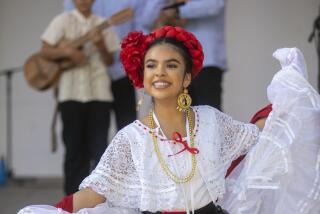‘Ramayana’ Brings to Life Ancient Myth From Asia
- Share via
A four-hour compendium of Asian performing traditions, “Ramayana L.A.,” brought to USC on Sunday half a dozen locally based groups intent on showing how the same ancient myth dramatically changed yet remained uniquely itself in an odyssey of many centuries and thousands of miles.
Some of the barefoot dancers wore elegant anklets and others massive ankle bells. The face of evil in the story could be painted a livid red or a poisonous green. The noble heroine might prove most notable for her darting eyes, her trembling fingers or her floating balances. No matter: “Ramayana” is always a tale of lust and abduction, of war and faith--filled with characters who look like birds, monkeys and warriors but who just might be kings or gods.
And that tale did take hold, though the eight-part program sometimes seemed as disorganized, shapeless and even silly as any high school “Christmas in Many Lands” pageant. Presented by the Music Circle in Bovard Auditorium (with a related daylong food and craft festival just outside), the performance began where “Ramayana” did 3,000 years ago: in India, with vibrant segments danced by Anjani and Amrapali Ambegoakar (North Indian Kathak) and by Ramaa Bharadvaj and the Angahara Ensemble (South Indian Bharata Natyam).
Next came the elegant royal court traditions of Thailand, represented by Viroj Sirironarong and Company, and the related classicism of Cambodia, embodied by Sophiline Cheam Shapiro and Danse Celeste.
Participants from California Institute of the Arts and UCLA lent their weight to the large-scale Indonesian groups: I Nyoman Wenten’s Gamelan Burat Wangi and Dancers (Bali) and Djoko Walujo’s Gamelan Kyai Doro Dasih and Dancers (Java). Presiding over the occasion, and introducing many of the musicians who gave the event so much of its richness and immediacy: Music Circle co-founder and Executive Director Harihar Rao.
It would be foolish to pretend that all the performers proved equally distinguished, but their presence in the same “Ramayana” not only provided a fascinating cross-cultural dialogue but made a profound statement about the traditions of fabled, exotic, mysterious Southern California.
From Denishawn early in the century through the founding of Aman and Avaz, local audiences have viewed with interest and respect dance legacies that evolved far beyond our borders. That interest and respect has also helped make the area a welcoming environment for immigrant performing groups. “Ramayana” may not yet belong to the Southland in the same way as, say, “Ramona,” but give us time. When a cell phone began to ring in the audience Sunday and sounded perfectly in tune with the rippling, bell-like gamelan music on stage, the names “Ramayana” and “L.A.” did indeed seem made for each other.
More to Read
The biggest entertainment stories
Get our big stories about Hollywood, film, television, music, arts, culture and more right in your inbox as soon as they publish.
You may occasionally receive promotional content from the Los Angeles Times.










